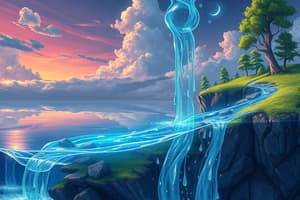Podcast
Questions and Answers
La evaporación es el proceso por el cual el agua líquida se transforma en vapor de agua principalmente debido a la radiación solar.
La evaporación es el proceso por el cual el agua líquida se transforma en vapor de agua principalmente debido a la radiación solar.
True (A)
La condensación ocurre cuando el vapor de agua se calienta y se convierte nuevamente en agua líquida.
La condensación ocurre cuando el vapor de agua se calienta y se convierte nuevamente en agua líquida.
False (B)
El agua en el suelo entra al flujo del agua a través del proceso de escorrentía.
El agua en el suelo entra al flujo del agua a través del proceso de escorrentía.
False (B)
La precipitación puede ocurrir en forma de lluvia, nieve, aguanieve o granizo dependiendo de la temperatura del aire.
La precipitación puede ocurrir en forma de lluvia, nieve, aguanieve o granizo dependiendo de la temperatura del aire.
Las temperaturas más altas aumentan la tasa de infiltración del agua en el suelo.
Las temperaturas más altas aumentan la tasa de infiltración del agua en el suelo.
La escorrentía superficial se produce cuando la lluvia excede la capacidad de infiltración del suelo.
La escorrentía superficial se produce cuando la lluvia excede la capacidad de infiltración del suelo.
La humedad alta reduce la tasa de evaporación del agua.
La humedad alta reduce la tasa de evaporación del agua.
Las superficies impermeables como el concreto aumentan la escorrentía en el suelo.
Las superficies impermeables como el concreto aumentan la escorrentía en el suelo.
Flashcards
Evaporation
Evaporation
Liquid water turning into water vapor due to heat, usually from the sun.
Precipitation
Precipitation
Water falling from the atmosphere as rain, snow, sleet, or hail.
Condensation
Condensation
Water vapor changing back into liquid water.
Infiltration
Infiltration
Signup and view all the flashcards
Runoff
Runoff
Signup and view all the flashcards
Water Cycle
Water Cycle
Signup and view all the flashcards
Evaporation Rate Factors
Evaporation Rate Factors
Signup and view all the flashcards
Precipitation Types
Precipitation Types
Signup and view all the flashcards
Study Notes
The Water Cycle
- The water cycle is a continuous process where water circulates between the Earth's surface and the atmosphere. This involves various stages: evaporation, precipitation, condensation, infiltration, and runoff (or surface runoff).
Evaporation
- Evaporation is the process by which liquid water changes to water vapor, mainly due to solar radiation.
- This vapor rises into the atmosphere.
- The rate of evaporation is influenced by factors like temperature, humidity, and wind speed.
- Increased temperature speeds up evaporation.
- Higher humidity reduces evaporation.
- Wind increases evaporation by carrying away the water vapor, preventing saturation and allowing more evaporation.
- Water bodies like oceans, lakes, and rivers are major sources of evaporation.
- Plants also contribute through transpiration.
Precipitation
- Precipitation occurs when water vapor in the atmosphere cools and condenses into larger droplets or ice crystals.
- These condensed particles become heavy enough to fall back to the Earth as rain, snow, sleet, or hail.
- The type of precipitation depends on the temperature profile of the atmosphere.
- Warm air can support rain, while colder air leads to snow or sleet.
- Temperature gradients are key to precipitation formation.
- Cloud formation and its type influence the form and magnitude of precipitation.
Condensation
- Condensation is the process where water vapor in the air changes back into liquid water.
- This occurs when the air cools down and the vapor molecules lose energy.
- Condensation is essential to cloud formation.
- Water vapor cools as it rises, and condensation forms clouds.
Infiltration
- Infiltration is the process where water on the ground surface enters the soil.
- The rate of infiltration depends on soil type, slope, vegetation cover, and rainfall intensity.
- Permeable soils allow more infiltration than impermeable soils.
- Vegetation cover can slow down surface runoff, increasing infiltration.
- Infiltrated water replenishes groundwater.
Runoff (Surface Runoff)
- Runoff or surface runoff is the flow of water over the Earth's surface.
- It occurs when rainfall or snowmelt exceeds the infiltration capacity of the soil.
- Runoff can lead to erosion and flooding.
- The rate of runoff is influenced by factors such as the intensity of rainfall. Topographical features like sloped land increase runoff.
- Impermeable surfaces like concrete and asphalt drastically increase runoff.
- Runoff transports eroded soil, pollutants, and other materials to rivers and streams, ultimately impacting water quality.
Summary of Interconnectedness
- The water cycle is a closed system, meaning water is constantly recycled.
- The various stages are interconnected. Evaporation fuels precipitation, and precipitation replenishes water bodies, groundwater, and soil moisture.
- Infiltration and runoff are competing processes that determine how much water drains to rivers and streams or seeps into the ground.
- Human activities, such as deforestation, urbanization, and land use change, can significantly impact the water cycle.
Studying That Suits You
Use AI to generate personalized quizzes and flashcards to suit your learning preferences.




